 Copyright 2008 by Ray Foley
Copyright 2008 by Ray Foley
Cover and internal design 2008 by Sourcebooks, Inc.
Cover photo iStock Sourcebooks and the colophon are registered trademarks of Source-books, Inc. All rights reserved. No part of this book may be reproduced in any form or by any electronic or mechanical means including information storage and retrieval systemsexcept in the case of brief quotations embodied in critical articles or reviewswithout permission in writing from its publisher, Sourcebooks, Inc. All brand names and product names used in this book are trademarks, registered trademarks, or trade names of their respective holders. Sourcebooks, Inc., is not associated with any product or vendor in this book. Some recipes contained herein may call for raw or undercooked eggs.
Please consult with your physician prior to consumption. The Author and Sourcebooks, Inc., shall have neither liability nor responsibility to any person or entity with respect to any loss, damage, or injury caused or alleged to be caused directly or indirectly by the information in this book. Published by Sourcebooks, Inc.
P.O. Box 4410, Naperville, Illinois 60567-4410
(630) 961-3900
Fax: (630) 961-2168
www.sourcebooks.com Library of Congress Cataloging-in-Publication Data Foley, Ray. The rum 1000 : the ultimate collection of rum cocktails, recipes, facts, and resources / Ray Foley. cm. cm.
Includes index. 1. Cocktails. 2. Rum. 3.
Cookery (Rum) I. Title. II. Title: Rum one thousand. III. Title: Rum thousand.
TX951.F59457 2008
641.8'74dc22 2007051445 Printed and bound in the United States of America. BG 10 9 8 7 6 5 4 3 2 1
Publisher's Note: This book and the recipes contained herein are intended for those of a legal drinking age. Please drink responsibly and ensure you and your guests have a designated driver when consuming alcoholic beverages.  To :
To :
Jaclyn Marie Foley and Ryan
plus
The Other Tribe: Raymond Pindar, Amy, and Mr. Bill
also
The Readers of Bartender Magazine ,
www.bartender.com, and www.USBartender.com 
 F irst and foremost, Sara Kase and Peter Lynch at Sourcebooks (www.sourcebooks.com). I would also like to thank the following for their assistance in the completion of this book: Vic Morrison at McCormick Distilling; Greg Cohen at the Richards Group in Dallas; Pyrat Rum; Michel Roux at Crillon Importers; Jim Nikola at Crillon Importers; the great folks at Bacardi; Jose Cuervo; Diageo; Tabasco; the Food Group; Skyy Spirits; Barton Brands; Cointreau; Coco Lopez; Lyndon Chin at Group LIH; Rums of Puerto Rico; Henry Preiss at PreissImports.com; Larrain Gracia at Edelman.com; Tortuga Rum Company; Angostura, Ltd.; Pusser Rum; Cruzan Rum; Laura Baddish at the Baddish Group; Sarah Zeller of Sidney Frank Importing Co.; Michael Kuropatkin of Carat, N.Y.C.; Jeff Pogash at Mot Hennessy; Peter Nelson and crew at Niche Importing, New Jersey; and all the other rum companies that assisted in the completion of The Rum 1000.
F irst and foremost, Sara Kase and Peter Lynch at Sourcebooks (www.sourcebooks.com). I would also like to thank the following for their assistance in the completion of this book: Vic Morrison at McCormick Distilling; Greg Cohen at the Richards Group in Dallas; Pyrat Rum; Michel Roux at Crillon Importers; Jim Nikola at Crillon Importers; the great folks at Bacardi; Jose Cuervo; Diageo; Tabasco; the Food Group; Skyy Spirits; Barton Brands; Cointreau; Coco Lopez; Lyndon Chin at Group LIH; Rums of Puerto Rico; Henry Preiss at PreissImports.com; Larrain Gracia at Edelman.com; Tortuga Rum Company; Angostura, Ltd.; Pusser Rum; Cruzan Rum; Laura Baddish at the Baddish Group; Sarah Zeller of Sidney Frank Importing Co.; Michael Kuropatkin of Carat, N.Y.C.; Jeff Pogash at Mot Hennessy; Peter Nelson and crew at Niche Importing, New Jersey; and all the other rum companies that assisted in the completion of The Rum 1000.
To Marc Pickard for keeping my computer going; Erin Mackey for her assistance, being the best, and continuing her education; Loretta Natiello for being my best friend; Jimmy Zazzali, for being a great bartender and friend; Matt Wojciak; John Cowan; Mike Cammarano; Marvin Solomon; Jack Foley, Jr.; and, of course, the great Hymie Lipshitz. And also to all those who submitted recipes to www.bartender.com and the readers of Bartender Magazine. To all the great bartenders who have served me in America and around the world! The Best!  Y o! Ho! Ho! And a bottle of rum! From history to recipes to resources, The Rum 1000 will assist you in the drinking and cooking of rum like no other book will. Whether you are a home bartender or a professional bartender, this guide will be a great reference. Keep it next to your bottle of rum. A few notes on the recipes: Sugar-free juice or diet soda can be substituted in any drink.
Y o! Ho! Ho! And a bottle of rum! From history to recipes to resources, The Rum 1000 will assist you in the drinking and cooking of rum like no other book will. Whether you are a home bartender or a professional bartender, this guide will be a great reference. Keep it next to your bottle of rum. A few notes on the recipes: Sugar-free juice or diet soda can be substituted in any drink.
For example, if a recipe calls for lemonade, feel free to use sugar-free lemonade; if a recipe calls for tonic, feel free to use diet tonic. For martinis containing vermouth, the less vermouth, the drier the martini. Enjoy! Please drink in moderation and NEVER drink and drive. If you have any questions, I can be reached at barmag@aol.com. For more information on bartending, go to www.bartender.com.  The origins of rum date back more than two thousand years.
The origins of rum date back more than two thousand years.
The origin of sugarcane is Papua, New Guinea. Christopher Columbus first brought sugarcane to the Caribbean. Ponce de Leon planted the first sugarcane fields in Puerto Rico. The first sugar mill was built in Puerto Rico in 1525. The first still was built in 1893. The first rum was exported to the United States in 1897.
The first rum distillery in the United States appeared in 1664. Rum was used as a cure-all for many ailments in the Caribbean.
Rum is from the word rumbullion . Rumbullion means a great tumult or uproar. Others claim rum is from the Dutch word roemer .
Other names used for rum are: Nelson Blood, Navy Neater, Demon Water, and Pirate's Drink.
Rum is made from sugarcane by-products.
Rum is made from sugarcane by-products.
Sugarcane's by-products are molasses and sugarcane juice. Crude rum is first distilled to between 125 and 180 proof.
Most, but not all, rums come from Puerto Rico and the West Indies. Other countries producing rum are Brazil (called cachaca ), Venezuela, the United States, Canada (known as Screech ), Australia, Cuba, Bermuda (Gosling's), and Africa.
Rum also served as a medium of exchange and barter. Don Facundo Bacardi Masso is responsible for experimenting with distillation techniques; he is thus responsible for modern light rums and Bacardi.
Bacardi Y Compania was founded in 1862. Today Bacardi is the number one rum in the world. Puerto Rico is the largest producer of rum.
There are seven types, or grades, of rum. Light rums are also called: White or Silver. Gold rums are also called amber.
Spiced rums are flavored by adding spices and sometimes caramel. Dark rum is also known as black rum.
There are many types of flavored rums, such as coconut, Orange, Mango, and Citron.
Premium rums are made from small batches of aged and gently distilled rum. Overproof rums are rums with an alcohol percentage higher than 40, or rums higher than 80 proof.
Most rum is aged for at least one year.
Most rum is aged for at least one year.
Some rums are aged in used bourbon casks. Some rums are aged in other types of wooden casks. Other rums are aged in stainless steel tanks. Because of the tropical climate, rum matures faster than other types of alcohol.
As much as 10 percent of rum is lost during aging through evaporation. This is called the angel's share.
After aging, rum is blended to ensure great flavor.
Rhum is a term used in French-speaking islands. Ron Aejo means a rum that has been significantly aged. Rhums, or agricultural Rhums, are distilled directly from harvested sugarcane.
In 2006, 22.7 million cases of rum were sold in the U.S.
Next page
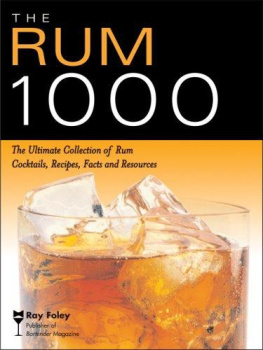

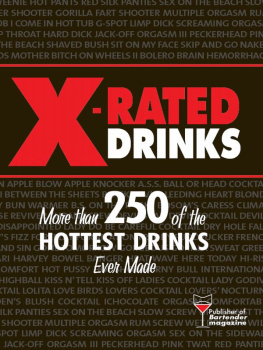
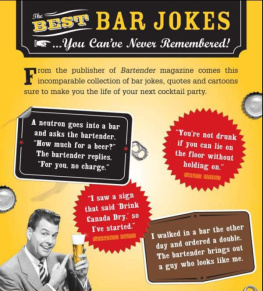

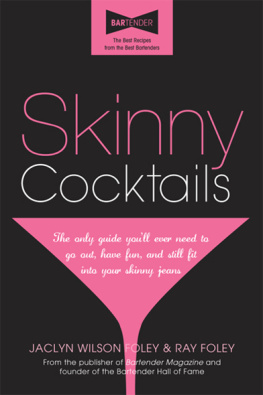
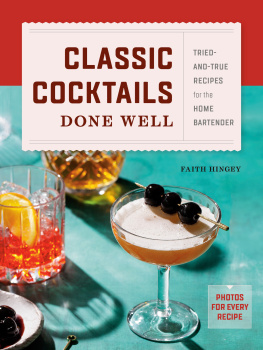
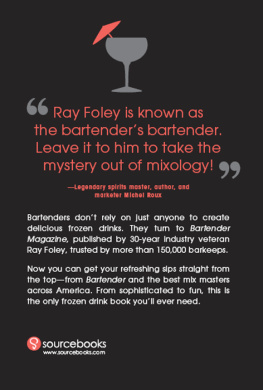

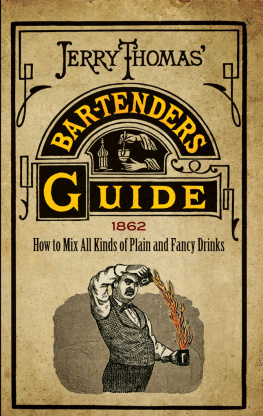
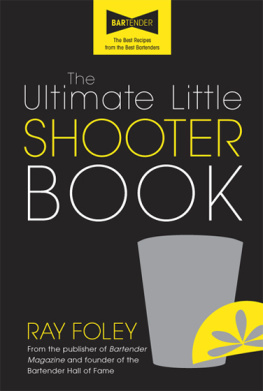

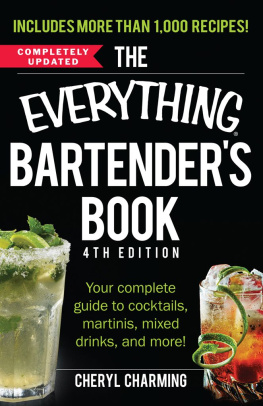
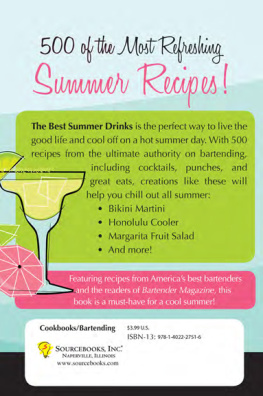
 Copyright 2008 by Ray Foley
Copyright 2008 by Ray Foley To :
To :
 F irst and foremost, Sara Kase and Peter Lynch at Sourcebooks (www.sourcebooks.com). I would also like to thank the following for their assistance in the completion of this book: Vic Morrison at McCormick Distilling; Greg Cohen at the Richards Group in Dallas; Pyrat Rum; Michel Roux at Crillon Importers; Jim Nikola at Crillon Importers; the great folks at Bacardi; Jose Cuervo; Diageo; Tabasco; the Food Group; Skyy Spirits; Barton Brands; Cointreau; Coco Lopez; Lyndon Chin at Group LIH; Rums of Puerto Rico; Henry Preiss at PreissImports.com; Larrain Gracia at Edelman.com; Tortuga Rum Company; Angostura, Ltd.; Pusser Rum; Cruzan Rum; Laura Baddish at the Baddish Group; Sarah Zeller of Sidney Frank Importing Co.; Michael Kuropatkin of Carat, N.Y.C.; Jeff Pogash at Mot Hennessy; Peter Nelson and crew at Niche Importing, New Jersey; and all the other rum companies that assisted in the completion of The Rum 1000.
F irst and foremost, Sara Kase and Peter Lynch at Sourcebooks (www.sourcebooks.com). I would also like to thank the following for their assistance in the completion of this book: Vic Morrison at McCormick Distilling; Greg Cohen at the Richards Group in Dallas; Pyrat Rum; Michel Roux at Crillon Importers; Jim Nikola at Crillon Importers; the great folks at Bacardi; Jose Cuervo; Diageo; Tabasco; the Food Group; Skyy Spirits; Barton Brands; Cointreau; Coco Lopez; Lyndon Chin at Group LIH; Rums of Puerto Rico; Henry Preiss at PreissImports.com; Larrain Gracia at Edelman.com; Tortuga Rum Company; Angostura, Ltd.; Pusser Rum; Cruzan Rum; Laura Baddish at the Baddish Group; Sarah Zeller of Sidney Frank Importing Co.; Michael Kuropatkin of Carat, N.Y.C.; Jeff Pogash at Mot Hennessy; Peter Nelson and crew at Niche Importing, New Jersey; and all the other rum companies that assisted in the completion of The Rum 1000. Y o! Ho! Ho! And a bottle of rum! From history to recipes to resources, The Rum 1000 will assist you in the drinking and cooking of rum like no other book will. Whether you are a home bartender or a professional bartender, this guide will be a great reference. Keep it next to your bottle of rum. A few notes on the recipes: Sugar-free juice or diet soda can be substituted in any drink.
Y o! Ho! Ho! And a bottle of rum! From history to recipes to resources, The Rum 1000 will assist you in the drinking and cooking of rum like no other book will. Whether you are a home bartender or a professional bartender, this guide will be a great reference. Keep it next to your bottle of rum. A few notes on the recipes: Sugar-free juice or diet soda can be substituted in any drink. The origins of rum date back more than two thousand years.
The origins of rum date back more than two thousand years.